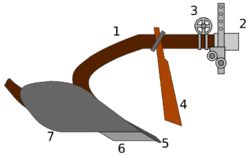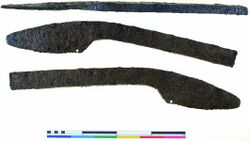Coulter (agriculture)
Topic: Engineering
 From HandWiki - Reading time: 2 min
From HandWiki - Reading time: 2 min
A (US:) colter / (British:) coulter (Latin 'culter' = 'knife') is a vertically mounted component of many ploughs that cuts an edge about 7 inches (18 cm) deep ahead of a plowshare.[1] Its most effective depth is determined by soil conditions.[2]
History
Its earliest design consisted of a knife-like blade.[3][1] In 2011 an early medieval coulter was excavated from a site in Kent, England.[4][5] Coulters using a flat rotating disc began being used c. 1900.[6][1] Its advantage was a smoothly cut bank, and it sliced plant debris to the width of the furrow.[2]
Results
In his 1854 book, Henry Stephens used dynamometer measurements to conclude that a plough without a coulter took about the same amount of force to pull but using a coulter resulted in a much cleaner result.[1] It softens the soil, allowing the plough to undercut the furrow made by the coulter.[1]
Jointer
A rolling coulter has an optional accessory called a "jointer".[2] The jointer flips over a small part of the surface on top of the slice before the plowshare flips the main slice.[2] It ensures that all of the plant debris gets covered by the flipped slice.[2]
References
- ↑ 1.0 1.1 1.2 1.3 1.4 Stephens, Henry (1854). The Book of the Farm Vol 1. W. Blackwood. pp. 271–272. https://books.google.com/books?id=X15GAAAAYAAJ&q=%22coulter%22+-ann+plow&pg=PA272.
- ↑ 2.0 2.1 2.2 2.3 2.4 Bacon, Charles Allen (1920). The Oliver plow book: a treatise on plows and plowing. Oliver Farm Equipment Company. pp. 160–162. https://books.google.com/books?id=nAY9AAAAYAAJ&q=%22coulter%22+-ann+plow&pg=PA160.
- ↑ Our Steel Beam Rod Breakers from $6.50 to $7.70. 1896 Sears Roebuck & Co. catalog.
- ↑ Thomas, Gabor; McDonnell, Gerry; Merkel, John; Marshall, Peter (2016). "Technology, ritual and Anglo-Saxon agriculture: the biography of a plough coulter from Lyminge, Kent" (in en). Antiquity 90 (351): 742–758. doi:10.15184/aqy.2016.73. ISSN 0003-598X. https://www.cambridge.org/core/journals/antiquity/article/technology-ritual-and-anglosaxon-agriculture-the-biography-of-a-plough-coulter-from-lyminge-kent/3EA15DA20A8F6153299E4561008E345C.
- ↑ "Anglo-Saxon 7th Century plough coulter found in Kent" (in en-GB). BBC News. 2011-04-07. https://www.bbc.com/news/uk-england-12997877.
- ↑ Our $9.75 Walking Plow. 1896 Sears Roebuck & Co. Catalog.
 |
 KSF
KSF


